“Design” may be too strong a term for how we created our landscape. We aren’t designers, and when we started our habitat garden project in the late ’90s, there wasn’t much information available on designing a habitat garden.
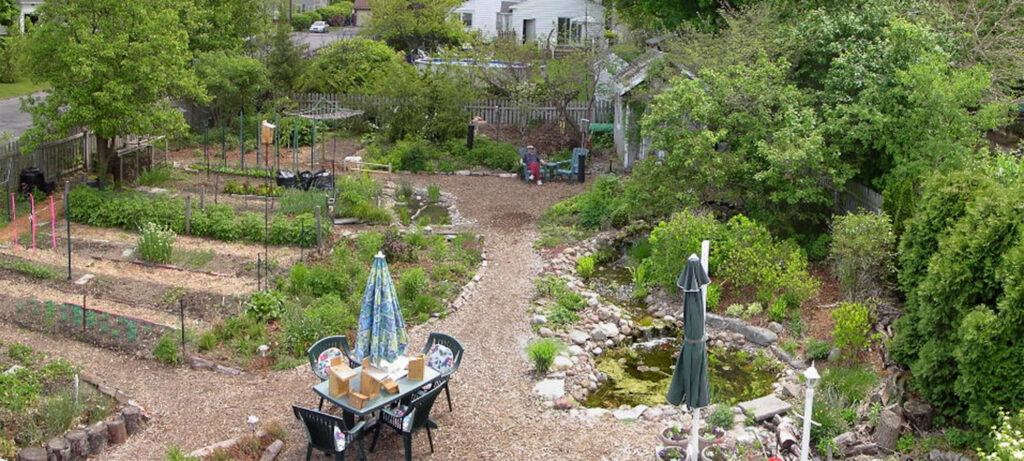
Our yard’s design is what has evolved over the years and was designed by us — people who didn’t always know what we were doing.
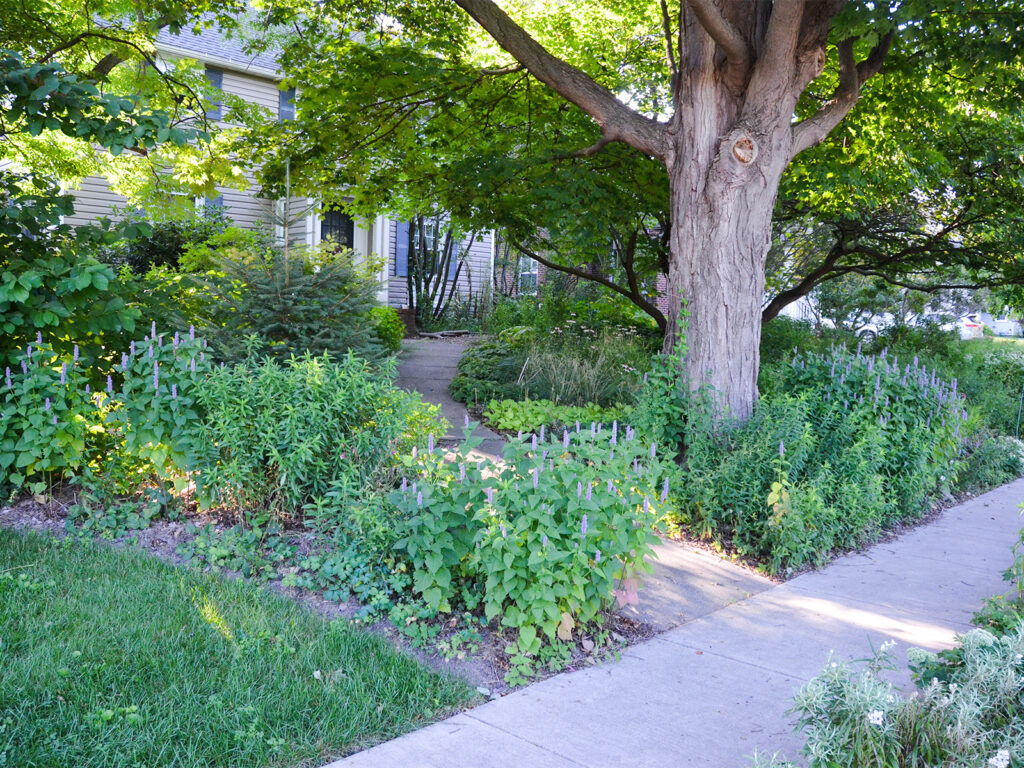
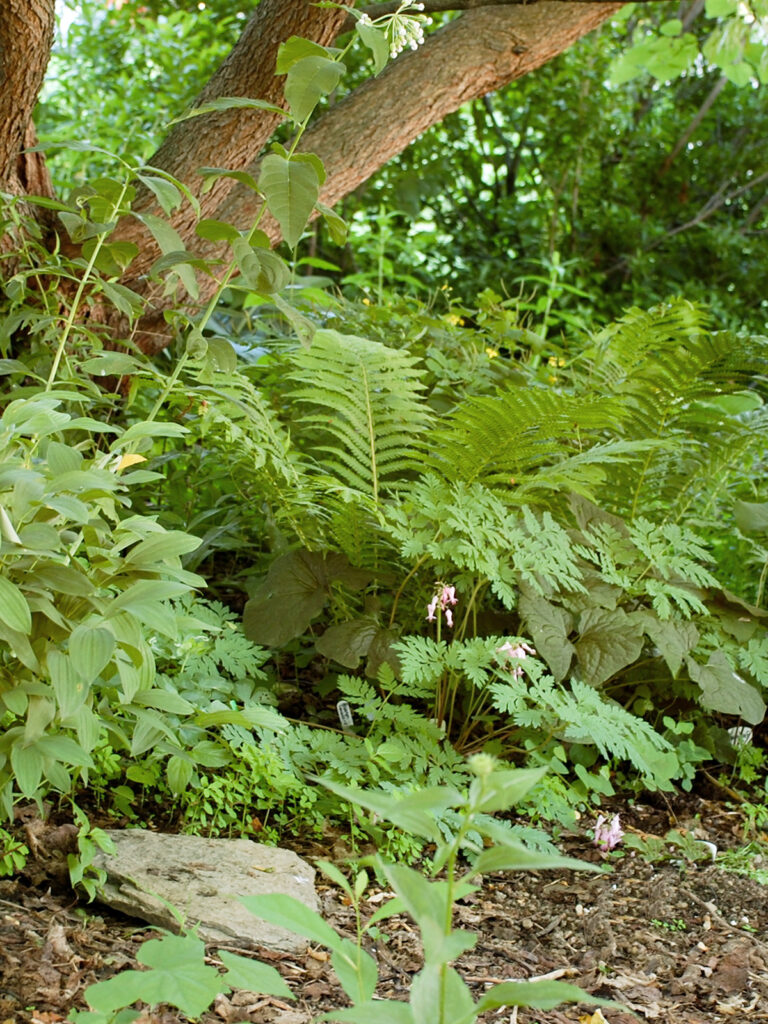
The good news is that even though our yard is not (and wasn’t meant to be) an “ooh and aah” kind of garden, it’s attractive enough, gets plenty of compliments, and is a very enjoyable place to be.
Most important, it provides lots of habitat for its size and helps create a healthier planet.
As the landscape designer Edwina Von Gal titled one of her talks: “The Eye of the Beholder: Is it messy or an acquired taste?” It’s definitely a taste we have acquired!
This page describes our general design ideas, but we have the specifics of various parts of our yard on these pages:
Our design goals
Our main habitat design goal was to create a three-dimensional space that was varied enough to provide for a number of creatures, but which had enough of any one thing to be actually useful.
For example, one milkweed plant is theoretically enough for a monarch to lay her eggs on, but it’s less likely a monarch would notice it as easily as a whole patch.
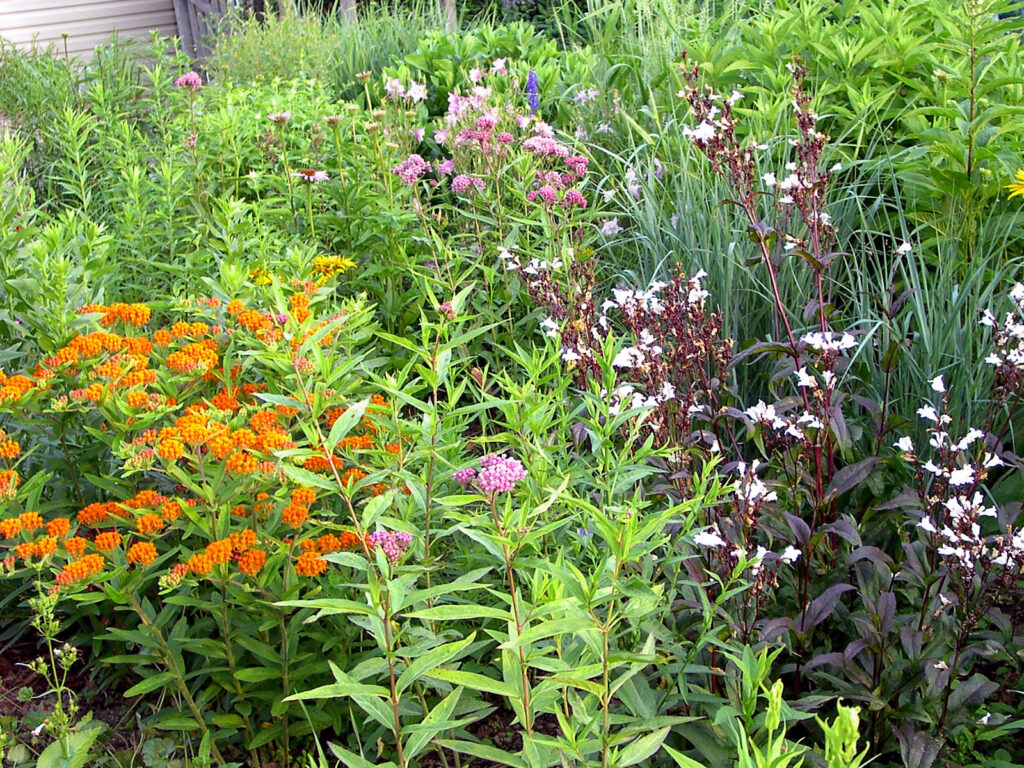
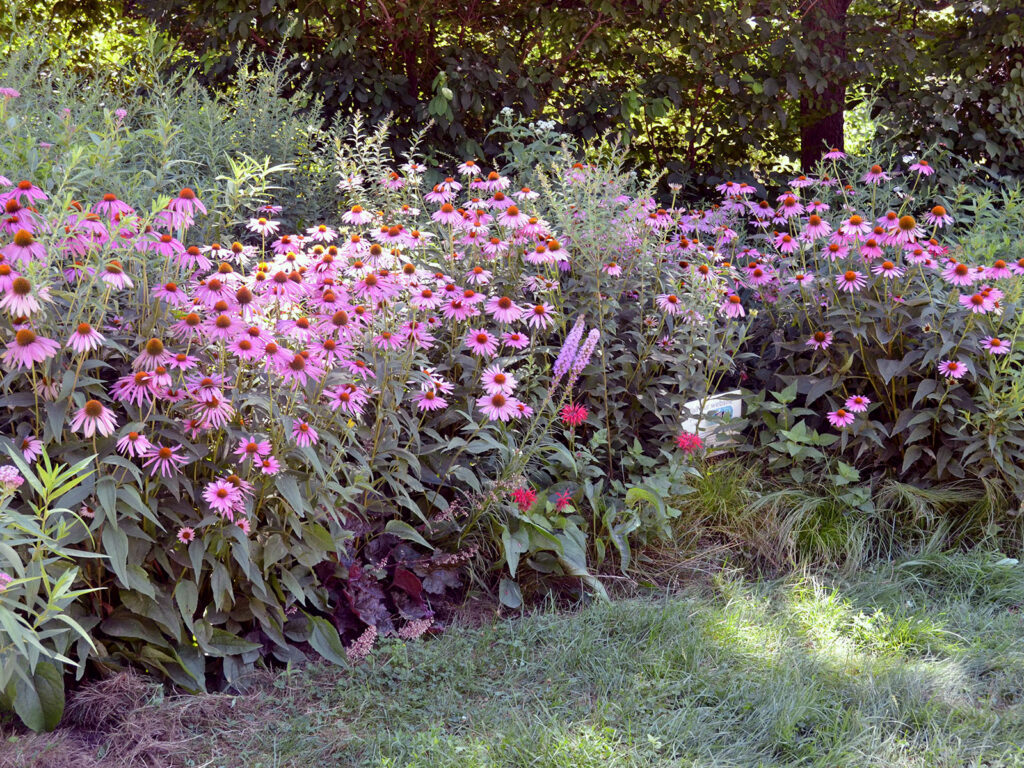
Initially I may have had too many different kinds of plants in my small space.
On the other hand, I enjoy seeing how different plants grow and develop, and it’s much cheaper to buy one plant of something and be patient and let it spread or multiply by division.
On our smallish lot (about 80 x 180 feet), if I had large swath of one kind of plant, I’d never get to grow many of the plants I want. Eventually, as the single plants we purchased multiplied, we’ve ended up with medium-sized patches of various kinds of plants.
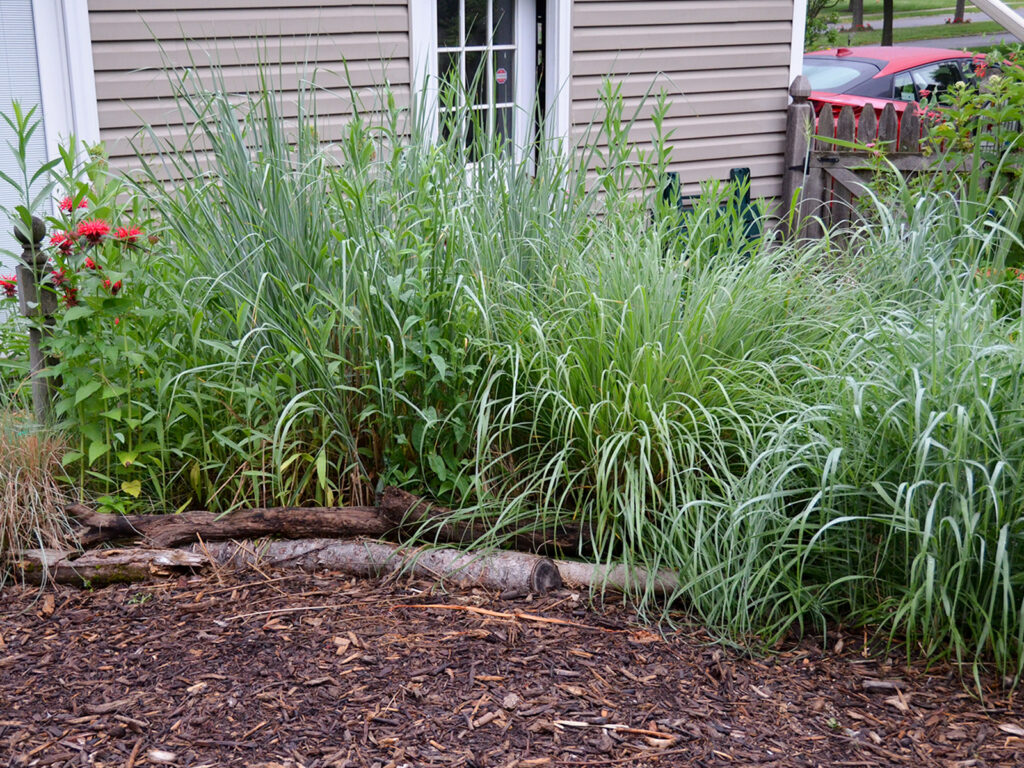
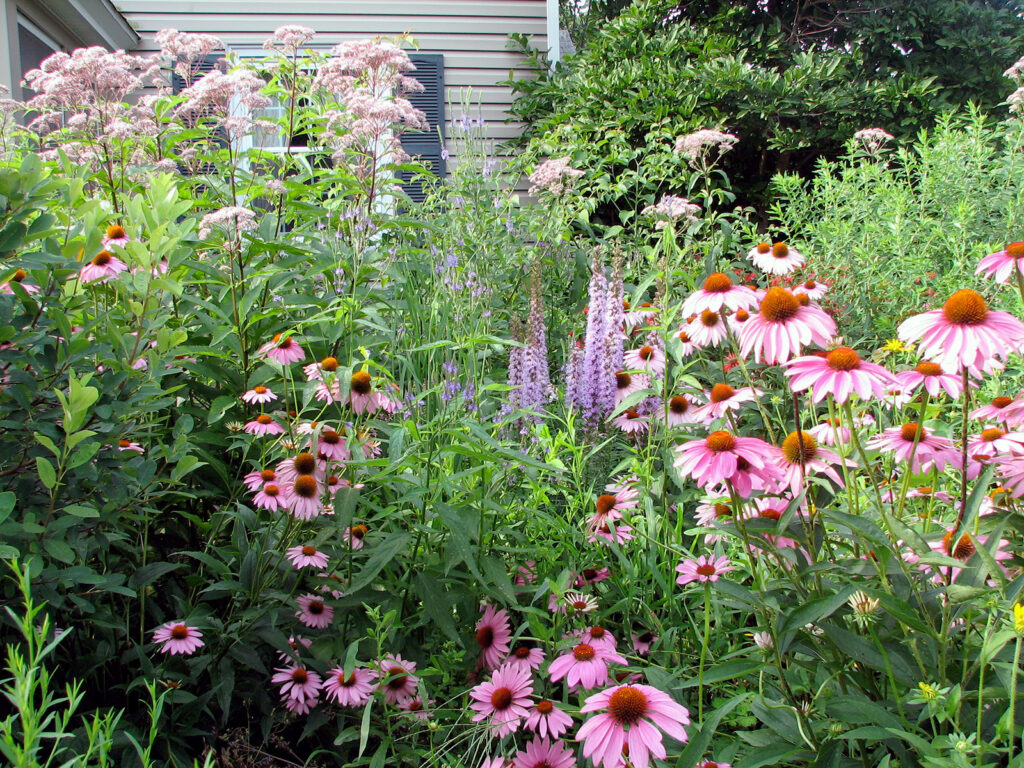
Another design goal was to be able to enjoy our screen porch (the edge of which is at the top left), which is on the north side of our house exposed to both the front and side streets of our corner lot.
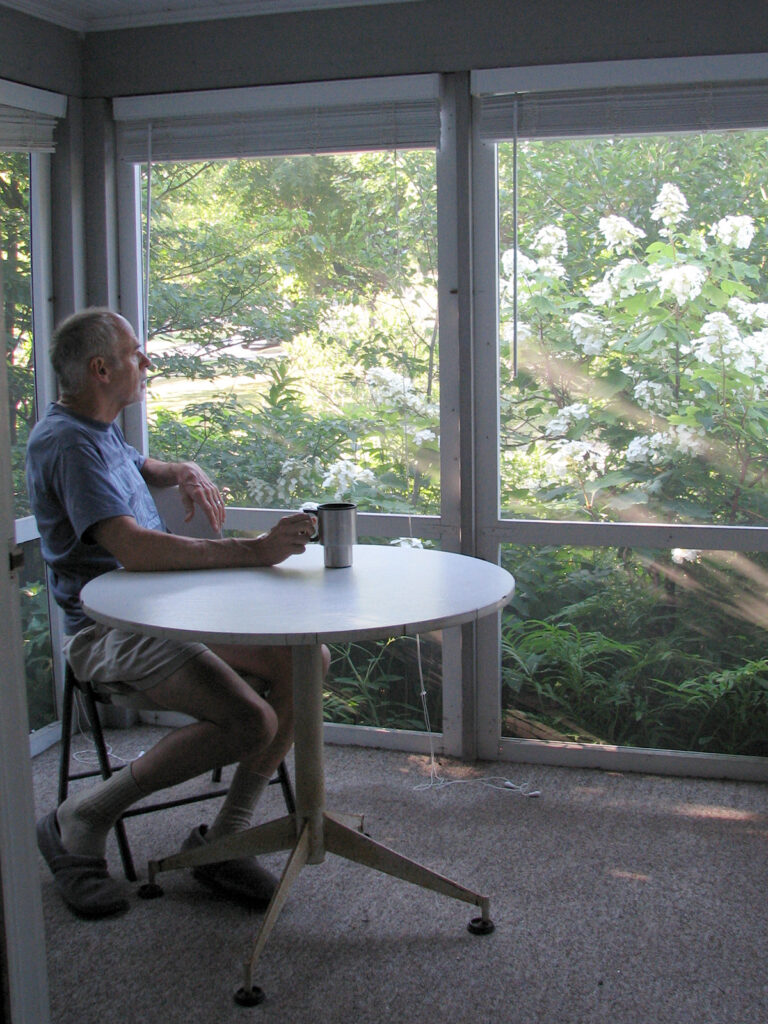
Even though we’re fairly close to these streets, we feel we’re in a secluded forest-y environment, full of birds — drawn to the serviceberries and pagoda dogwood berries — and buzzy bees — drawn by the many flowers throughout the season.
We had rarely used this screen porch in the past, but it now has become a favorite place when we aren’t actually outside — a quality habitat for people!
Basic design principles we used
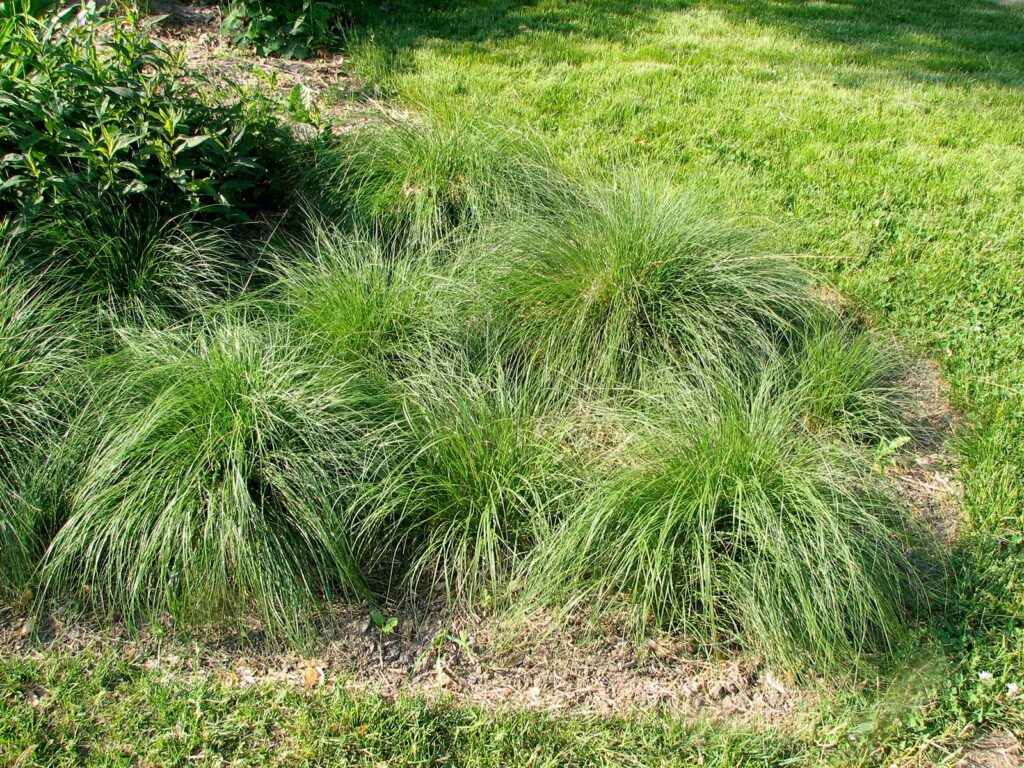
Though we definitely aren’t professional landscape designers, there are general principles that most gardening books describe.
This group of prairie dropseed illustrates some of these tried and true design principles:
- Create groups, not just one or two isolated plants. At least this is our ultimate goal. For budget reasons, we generally start with just one of a kind, unless they’re inexpensive plugs. And who knows if a particular species likes your environment? Plants tend to either thrive or die. Either way, starting with one or just a few makes sense.
- Plant in odd numbers. A group of three or five plants look so much better than two or four, and plants arranged in an informal group look better than those lined up like soldiers. Eventually, though, our plants have multiplied and grown together, so we don’t see individual plants anyway.
- Plant things roughly from low to high as you’ll be looking at them, but this doesn’t have to be in perfect order.
- Create broad curving borders. Lots of ins and outs like rick-rack isn’t very pleasing, and there has to be enough of a curve to be an obvious or it will look like a straight line that isn’t quite straight. Laying out a hose to see what the curve will look like can help.
- Create large beds rather than lots of smaller beds.
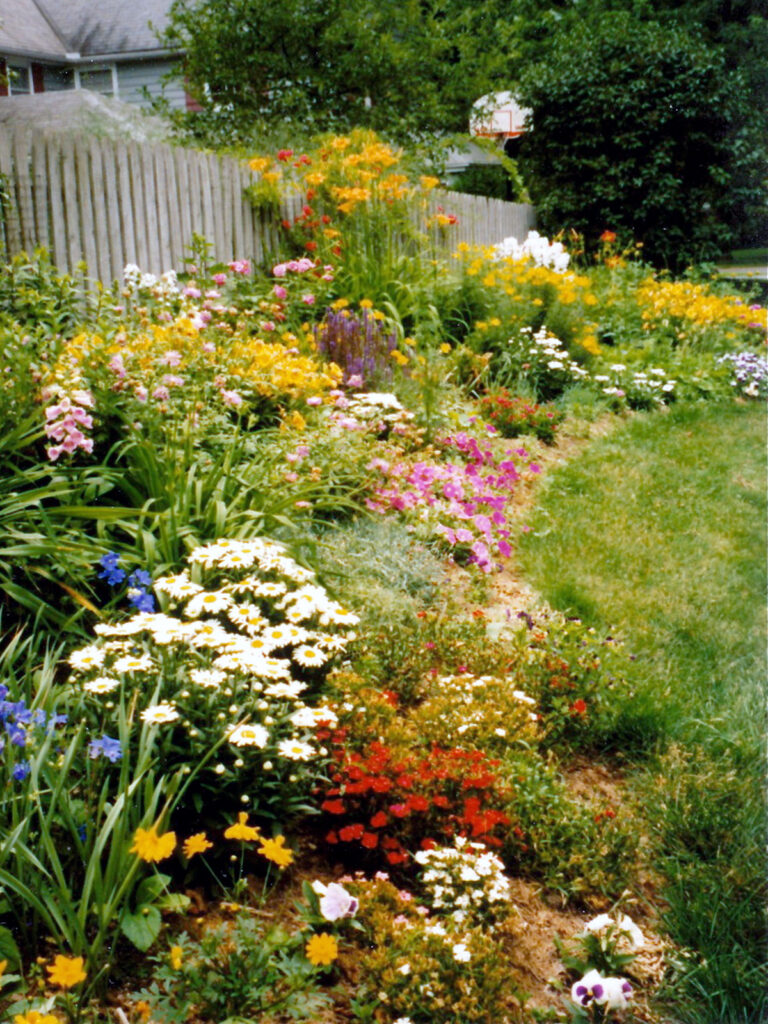
Our old ornamental garden’s border was a curving line. This works for native plant gardens, too!
And as some people have said, your lawn chair is your best design tool. Take some time to observe your yard: how people use it, and how wildlife uses it (or could use it). It’s also a good idea to know how much sun each area gets in various seasons. We spent a bit of time observing sun/shade patterns during different seasons to get a general idea of the conditions throughout the yard.
Things change
The design is ever-changing since these are living things.
I suppose the ideal would be that every plant we bought would live, thrive and be in the right place. They sometimes aren’t in the right place, they don’t always thrive, and it’s in the nature of plants to eventually die.
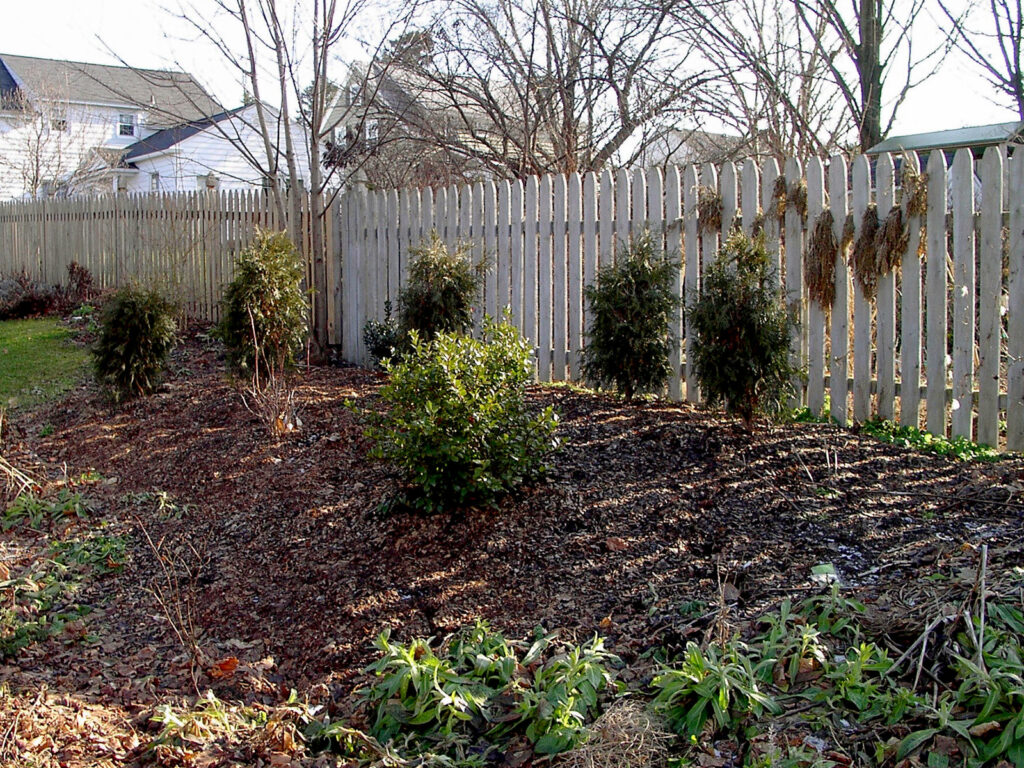
We try think in terms of the big picture, moving plants when necessary (though it does set them back), and trying not to get upset about the ones that die.
Fortunately, plants want to live and the overwhelming majority don’t just live, but reproduce in some way, either naturally, or with some gardener’s help.
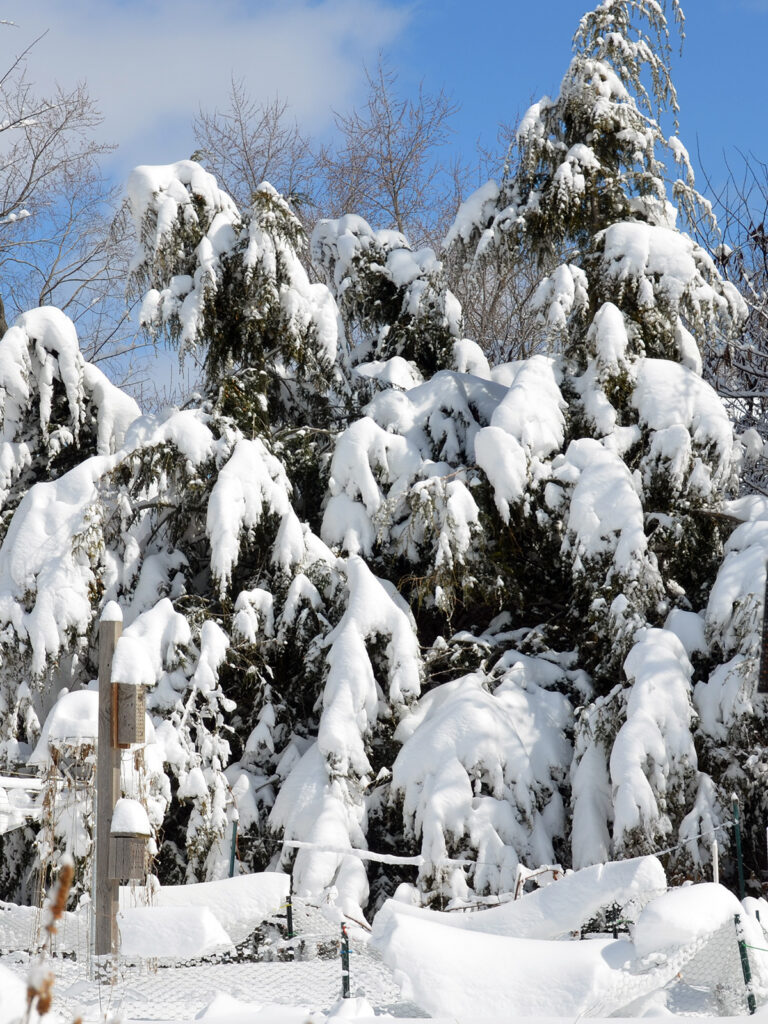
The fate of any one plant (unless it’s very special in some way) isn’t important as long as the landscape in general is full of healthy plants.
And the ones that thrive also change the character of the original design.
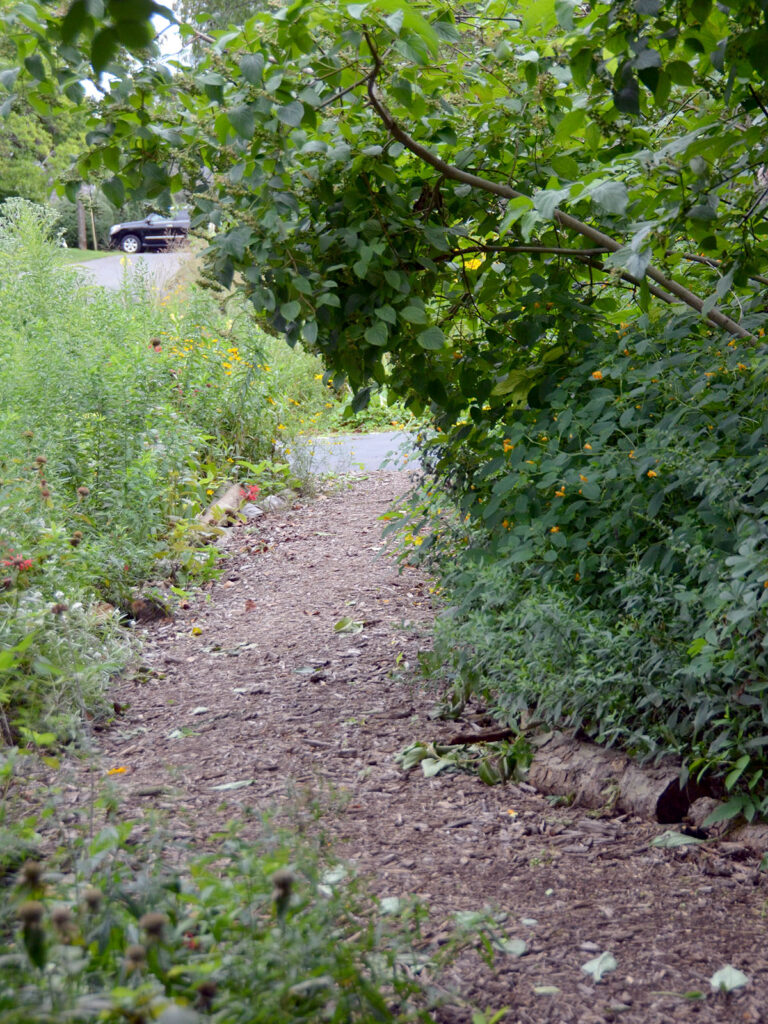
We didn’t always plan for enough space to accommodate plants as they grew to their mature size. In general this hasn’t been a problem since we aren’t trying to grow perfectly formed specimen plants.
Sometimes, though, they’ve outgrow their intended space, for example, extending into the paths. This isn’t the plants’ fault, of course! We didn’t carefully research their mature size when we planted them and couldn’t picture that little plant in a pot ever getting so large! This also shows that we’ve lost a neat edge on our paths.
(Years ago when we hired one of the area’s more expensive nurseries to design our front landscaping, they didn’t take mature plant size into account either. I think they expect you’ll just “redecorate” with new plants in a few years…)
NOT one of our goals: Neatness!
It’s great to have the inside of our house neat (we’re still working on that), but outside, those little bits of nature — dried grass and moss, little twigs, old flower stalks and flower heads, dead trees, and especially leaves — are important parts of our habitat.
They enrich the soil, provide essential nesting materials for birds and other creatures, provide places for insects to hide out (and for birds to find them), and much more.
And once you get used to that more “relaxed look,” it is much more interesting and (obviously) “natural.”
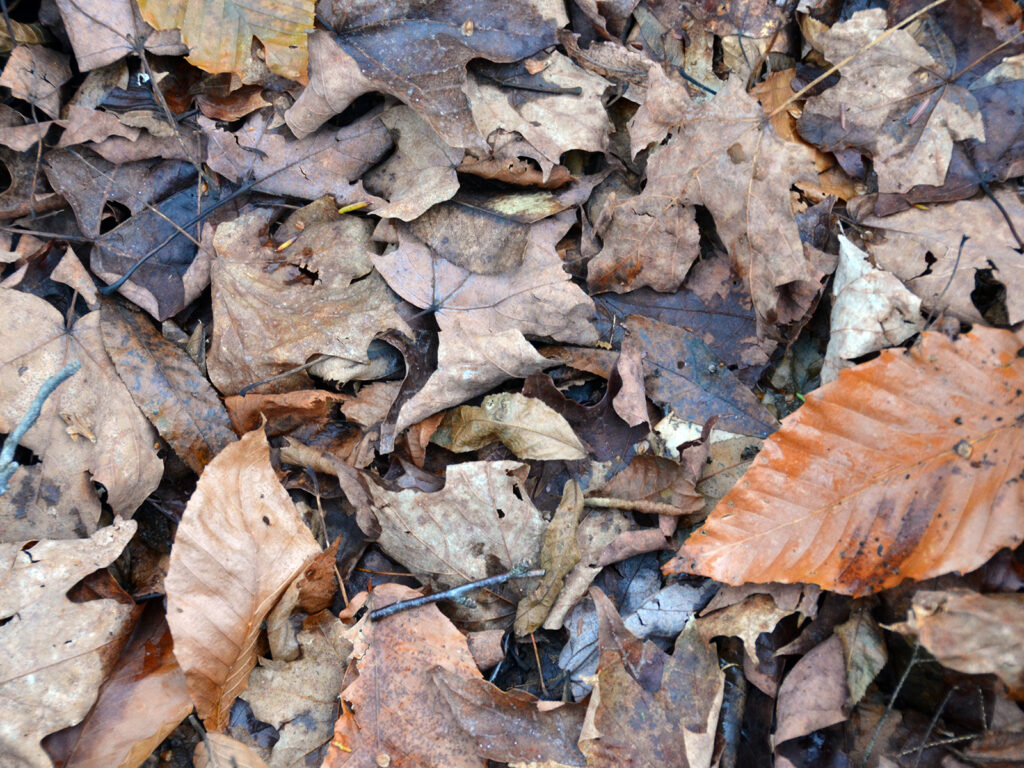
The main reason people spend so much effort neatening the yard may be that they’ve just gotten used to that sterile look that has come to define “pretty” landscaping. Or maybe it’s just fear of social disapproval, a disapproval that has been carefully nurtured for the last hundred years.
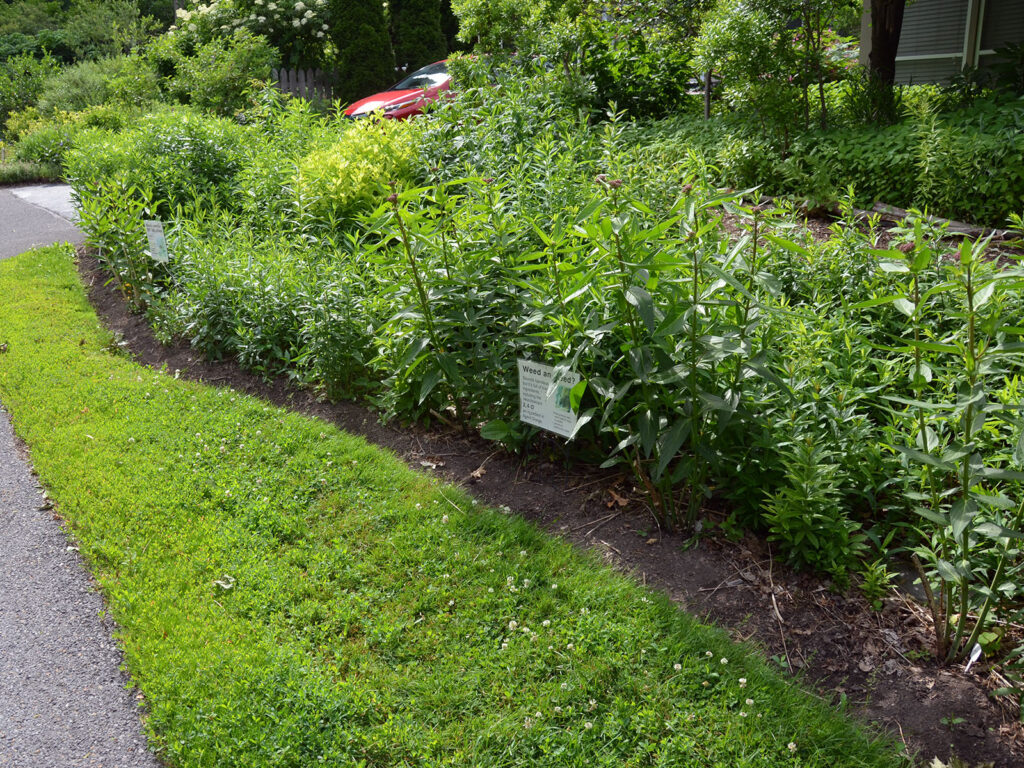
One thing we’ve learned is the impact having a neat border can have! Leaving a strip of bare dirt instantly makes the planting bed look neater, even while there are lots of plants packed into the bed.
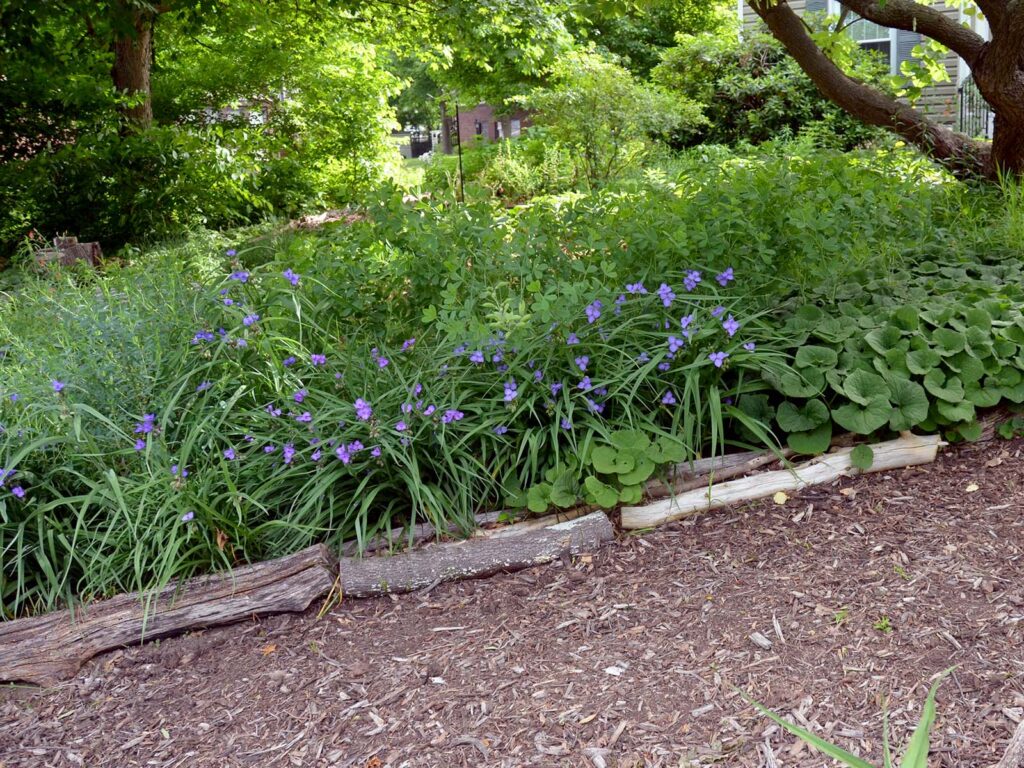
Keeping the logs edging the path visible also has a big impact.
And compare this with the photo of the path above when the log edge was overgrown. Edges make a huge difference!
The bottom line on “neatness”
We try to make our landscape as attractive as possible, but we’re more worried about the disapproval of our grandchildren thirty years from now, when they discover that our generation has denuded the planet, destroying biodiversity — and their futures.
Exterior lighting
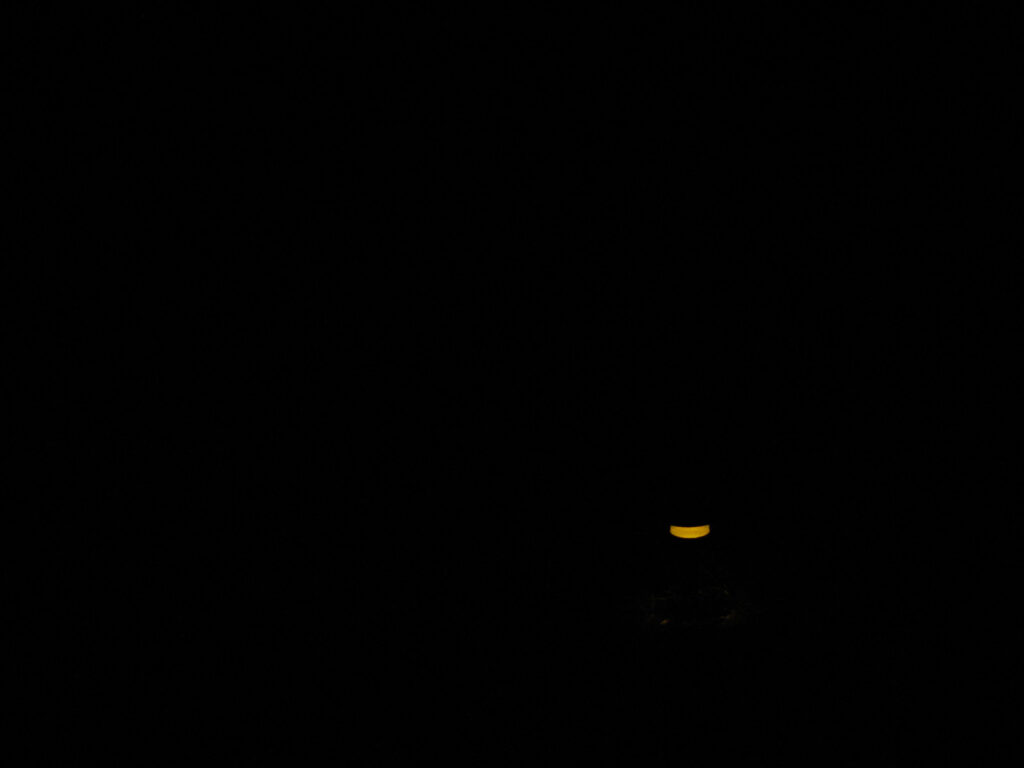
This is our backyard at night. It’s dark, as night should be.
How did we get to the point — in a warming world, no less — that people use electric lights (generally powered by fossil fuel) as a way to merely decorate their yards and house exteriors? This not only harms creatures that depend on night being dark but also is another way we lose our connection to the natural world.
For security lighting, we have a light on a motion detector, which comes on only when someone approaches. This is also a convenience when we come home since it lights up so we can find our keys.
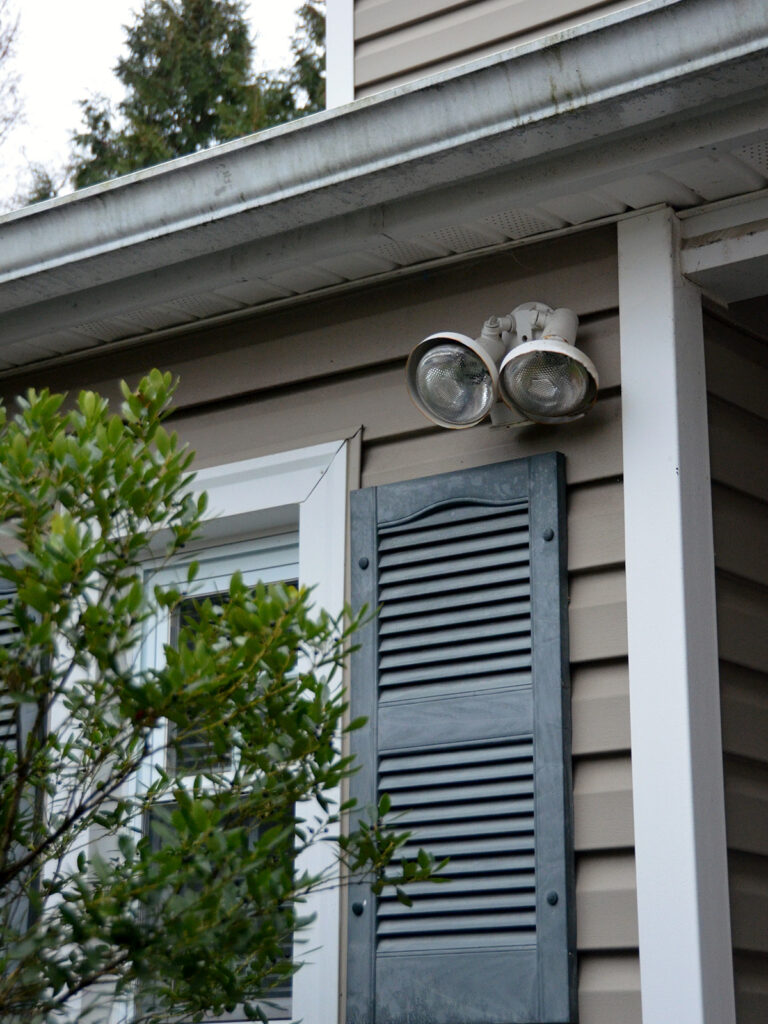
If we were to do it again …
If we were starting over, I think we might hire a natural landscaper to provide an overall design to be implemented in phases over the years.
WARNING: Yes, we’d probably hire a natural landscaper to design our yard if we were starting over, BUT… Natural landscaping and native plants are current buzz words, and not every landscaper will really design a natural landscape using native plants even if they say they are — or even if they think they are.
Trust, but verify with your own native plant references and be sure you make your intended outcome clear!
The few times we had professionals design small areas of our yard, we didn’t know much about habitat plants, and we later realized they didn’t do any better than we could have done ourselves — and much more cheaply at that.
A prime example is this hemlock an expensive local landscaper planted within a foot of a corner of our house! A hemlock is destined to become a large TREE that would never fit in the corner they put it in.
We had to remove it a few years later and decided we could make our own mistakes much more cheaply.
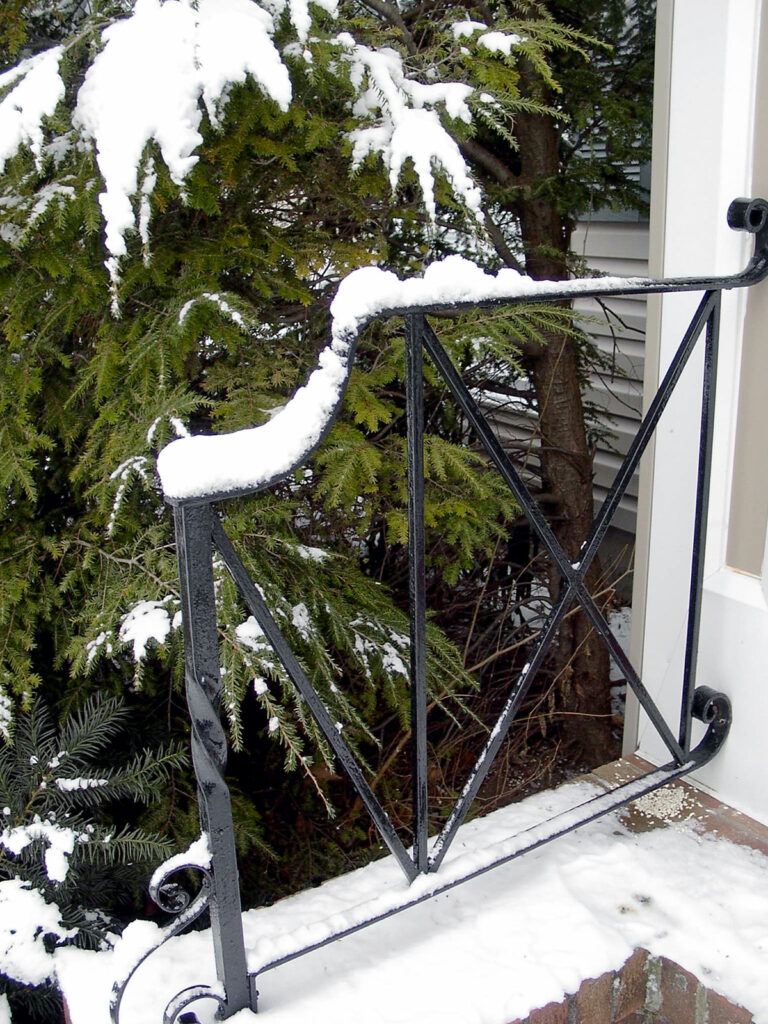
A TRULY knowledgeable NATURAL landscaper who knows and appreciates NATIVE plants will probably save you time, effort, and even money if you end up getting what you want and don’t have to repair mistakes.
But if you can’t find one, just start planting!
Resources
- Wild Ones:
- Native garden designs – Includes Meet the Designer videos, design plans and plant lists. These designs include plants specific to each location, but the design principles are useful anywhere; just substitute your own native plants
- Audubon at Home:
- Audubon Pennsylvania: Grow Native
- Guide to Gardening for Life (the left-hand menus have free downloads)
- Gardening in Southeastern Pennsylvania—the concepts are the same as for CNY, and many of the plants are, too
- Habitat Inventory—A simple worksheet to assess what you have now and to set goals for what you want to have in your habitat garden
- The Humane Gardener:
- Wild by design – Make it appealing to people, too!
- Dracula’s garden – three great groundcovers thought weeds
- Falling walls and rising ragworts
- Ecological Landscape Alliance:
- Planning for succession in a residential landscape – plan for change as plants grow!
- Amanda’s Native Plants:
- Garden Design:
- Less Lawn:
- LessLawn.com – Ideas for getting rid of lawn; also attractive designs to substitute
- Florida Atlantic University:
- The Royal Commission on Environmental Pollution:
- Pollinator Pathway:
- Pollinator Pathways Toolkit – a toolkit from Sarah Bergmann, the originator of the concept; watch her TED talk
- Cornell Lab All About Birds:
- NY Times:
- Meet an ecologist that works for God (and against lawns)
- Why the best trees aren’t always the biggest – Between a garden’s low ground cover and its tall canopy trees is a layer we often forget about. Here are the special, unsung native trees that can fill it.
Weeds?
- Wild Ones Fox Valley chapter:
- Wild Ones Journal:
- PennState Extension:
- Neighborly natural landscaping in residential areas – tips for a neighbor-friendly landscape; common myths about natural landscapes
- Humane Gardener:
- Butterflies: 1; Bullies: 0 – describes new law that “specifically codifies your right to be wildlife-friendly, plant-friendly, and environmentally conscious.”
Books
- Designing Gardens with Flora of the American East by Carolyn Summers helps you create a beautiful, socially acceptable yard using native plants.
- Planting Noah’s Garden: Further Adventures in Backyard Ecology by Sara Stein has a lot of practical tips in addition to inspiration!
Reflections
If suburbia were landscaped with meadows, prairies, thickets, or forests, or combinations of these, then the water would sparkle, fish would be good to eat again, birds would sing and human spirits would soar.
~ Lorrie Otto, Founder of Wild Ones
When their house was being completed they sent out the laborers to clear the property. It was March. No one knew when a clump of trembling aspens followed hawthorns and viburnums and crabs on to the roaring bon-fire. These were all ‘underbrush’ to the laborers, and they had been ordered to ‘Clear out the underbrush.’ When this job was finished, they took the heaped-up soil excavated for the basement, and spread it neatly and firmly to the four exact corners of the property. No one knew when a lush bed of white trilliums and sweet wild phlox was forever buried alive under a blanket of stiff wet clay. Nor did anyone realize that the leveled surface raised the soil several inches around the trunks of those white oaks and hickories that had been marked for preservation, and that this soil was cutting off the air supply of the feeding root tips, so that even these trees must soon die. The dying forest trees were gradually replaced, mostly with cottonwoods. Presently there was no undisciplined charm left to distract the inhabitants from a comparative contemplation of each others lawns and privet hedges. So they settled down to planting red geraniums on these rectangular graves where they had buried beauty.
~ May Theilgaard Watts, from Ravinia: Her Charms & Destiny
The garden of the future will be a shade garden. There are many reasons: fiscal, historical, environmental — and for the sake of our health and of the planet’s. In many ways this is an older notion of landscape — it’s planting for generations to come. It won’t happen overnight, though. For one thing, it means planting trees.
~ Ken Druse, The New Shade Garden, 2015
People often think of landscape design or gardening as a painting… But I think it’s more of a theater: You move through it, and things are always changing. There are sounds and smells and textures, and a story to it.
~ Marc Wolf, as quoted by Margaret Roach in the NYTimes
Our ability to perceive quality in nature begins, as in art, with the pretty. It expands through successive stages of the beautiful to values as yet uncaptured by language.
~ Aldo Leopold
Think of your garden not just as an extension of your house — a series of outdoor rooms, to use the current parlance — but as a habitat shared by you, plants, and the animals that depend on them for food and shelter.
~ William Cullina, Wildflowers: A Guide to Growing and Propagating Native Flowers of North America, p. 1
What is good may not look good, and what looks good may not be good. The difference between the scientific concept of ecology and the cultural concept of nature, the difference between function and appearance, demonstrates that applied landscape ecology is essentially a design problem. [The solution] requires placing unfamiliar forms inside familiar, attractive packages. It requires designing orderly frames for messy ecosystems.
~ Joan Iverson Nassauer, Landscape Journal, 1995
Replacing Ego-centric landscaping with Eco-centric landscaping is a bold and critical paradigm shift.
~ Susan Lerner, commenting on a NY Times article Corporate landscaping lets its hair down
